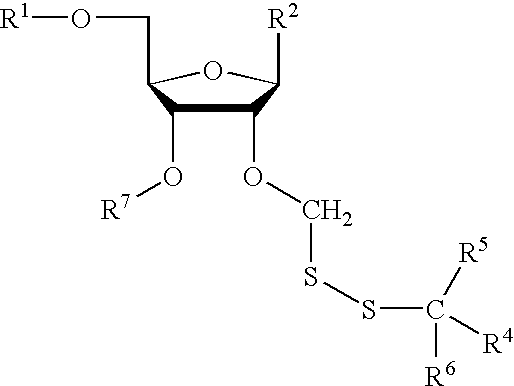Compounds for protecting hydroxyls and methods for their use
a technology of compound and hydroxyl, applied in the field of biological chemistry, can solve the problems of side reaction, inability to cleave or migrate intemucleotide phosphate bonds, and many protection groups suffer additional synthesis, etc., and achieve the effect of preventing cleavage or migration of intemucleotide phosphate bonds
- Summary
- Abstract
- Description
- Claims
- Application Information
AI Technical Summary
Benefits of technology
Problems solved by technology
Method used
Image
Examples
example 1
Synthesizing 5′-O-FMOC-Thymidine
[0079]Thymidine (10 mmol) was dried by coevaporation with dry pyridine (2×30 ml), re-dissolved in dry pyridine (50 ml) and cooled using an acetone / carbon dioxide bath to a temperature of −20° C. The thymidine solution was magnetically stirred and a dichloromethane solution of FMOC-Cl (12 mmol, 1.2 eq. in 20 ml DCM) was added over a period of 60 minutes. The reaction mixture was warmed to room temperature and stirred for additional 60 minutes. The reaction mixture was partitioned between saturated sodium hydrogen carbonate (250 ml) and dichloromethane (3×100 ml). The organic phase was saved, combined, evaporated and dried by coevaporation with toluene (2×50 ml) forming an oily residue. A pure product was crystallized from the oily residue using dichloromethane (30 ml) and benzene (50 ml) as solvent. Yield 76%—white crystals.
example 2
Synthesizing 5′-O-FMOC-3′-O-methylthiomethyl-thymidine.
[0080]The produce of Example 1 (5′-O-FMOC-Thymidine (7.0 mmol)) was dissolved in 50 ml of an acetic acid:acetic anhydride:DMSO solution (11:35:54, v / v) at 20° C. according to (Zavgorodny et al. (1991) Tetrahedron Lett. 32:7593-7596). The solution was stirred at 20° C. for 4 days resulting in a complete conversion of the starting material to methylthiomethyl ether derivative as monitored by thin layer chromatography (TLC). The solvent was evaporated using a rotary evaporator at 50° C. under high vacuum (oil pump). The residue was dissolved in ethanol (30 ml) and poured into vigorously stirred water (500 ml). A solid material precipitated and was filtered off. The precipitate was then dissolved in dichloromethane, coevaporated with toluene (2×50 ml), and flash chromatographed using dichloromethane:chloroform (1:1 v:v) as the solvent to give the final product as an oil. Yield 72%.
example 3
Synthesizing 5′-O-FMOC-3′-O-(4-methylphenyltbiosulfonatemethyl)-thymidine.
[0081]The product of Example 2 (5′O-FMOC-3′-O-methylthiomethyl-thymidine (4.0 mmol)) was dissolved in a solution of dichloromethane (20 ml) and bromine (Br2) (226 μl) was added at 20° C. After a 10 minute incubation, a potassium salt of p-toluenethiosulfonic acid (10.0 mmol) dissolved in dry DMF (10 ml) and lutidine (1.5 ml) was added. The reaction mixture was stirred for an additional 120 minutes, quenched by addition of saturated NaHCO3 and extracted with dichloromethane (3×50 ml). The resulting organic phase was evaporated, coevaporated with toluene, and flash chromatographed using chloroform as the final solvent. The final product was isolated as an oil. Yield 58%.
PUM
| Property | Measurement | Unit |
|---|---|---|
| temperature | aaaaa | aaaaa |
| temperature | aaaaa | aaaaa |
| v/v | aaaaa | aaaaa |
Abstract
Description
Claims
Application Information
 Login to View More
Login to View More - R&D
- Intellectual Property
- Life Sciences
- Materials
- Tech Scout
- Unparalleled Data Quality
- Higher Quality Content
- 60% Fewer Hallucinations
Browse by: Latest US Patents, China's latest patents, Technical Efficacy Thesaurus, Application Domain, Technology Topic, Popular Technical Reports.
© 2025 PatSnap. All rights reserved.Legal|Privacy policy|Modern Slavery Act Transparency Statement|Sitemap|About US| Contact US: help@patsnap.com



